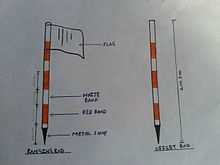Ranging rod

Ranging rod is an surveying instrument used for marking the position of stations and for sightings of those stations as well as for ranging the straight lines.[1] Initially these were made of light, thin and straight bamboo or of well seasoned wood such as teak, pine or deodar and were shod with iron at the bottom and surmounted with a flag about 25 cm square in size,[2] but nowadays these are made of metallic materials only. These are usually 3 cm in diameter and 2 m or 3 m long, painted alternatively either red and white or black and white in lengths of 20 cm (i.e. one link length of metric chain). These colours are used so that the rod is properly sited in case of long distances and bad weather. Ranging rods of more length i.e. 4 m to 6 m are called as Ranging poles and are used in in case of very long survey lines.[3] Another type of ranging rod is known as offset rod in which there is no flag at the top. It is used for measuring small offsets from the survey line when the work is of ordinary nature.[4]
Notes
When the ranging rods are limited, thin sticks 40 cm to 1 m length with white papers in the cuts at tops can serve their purpose. Such sticks are pointed at the bottom and are cut from wood. These are called as whites.
See also
References
- ↑ "free dictionary". Retrieved 19 November 2014.
- ↑ Surveying by prof. Cl Kocher in chapter Linear Measurements, page no. 19
- ↑ "elementary surveying instruments". Retrieved 19 November 2014.
- ↑ Surveying by prof. Cl Kocher, page 20